Holmesglen Institute: Carbohydrate Intake for Diabetes Management
VerifiedAdded on 2022/10/14
|5
|916
|326
Homework Assignment
AI Summary
This assignment explores the role of carbohydrates in diabetes management, focusing on both quality and quantity. It defines the glycemic index, explains how to describe it to a client, and identifies factors that affect it. The assignment uses the plate method for portion control, providing recommended servings of various food groups for a 19-50 year old. It also lists six strategies for regulating carbohydrate intake, such as eliminating sugary drinks and incorporating low-carb snacks. Furthermore, the assignment covers the classification and functions of macronutrients (carbohydrates, proteins, and fats), and differentiates between simple and complex carbohydrates. This comprehensive analysis provides a solid foundation for understanding carbohydrate management in the context of diabetes care.
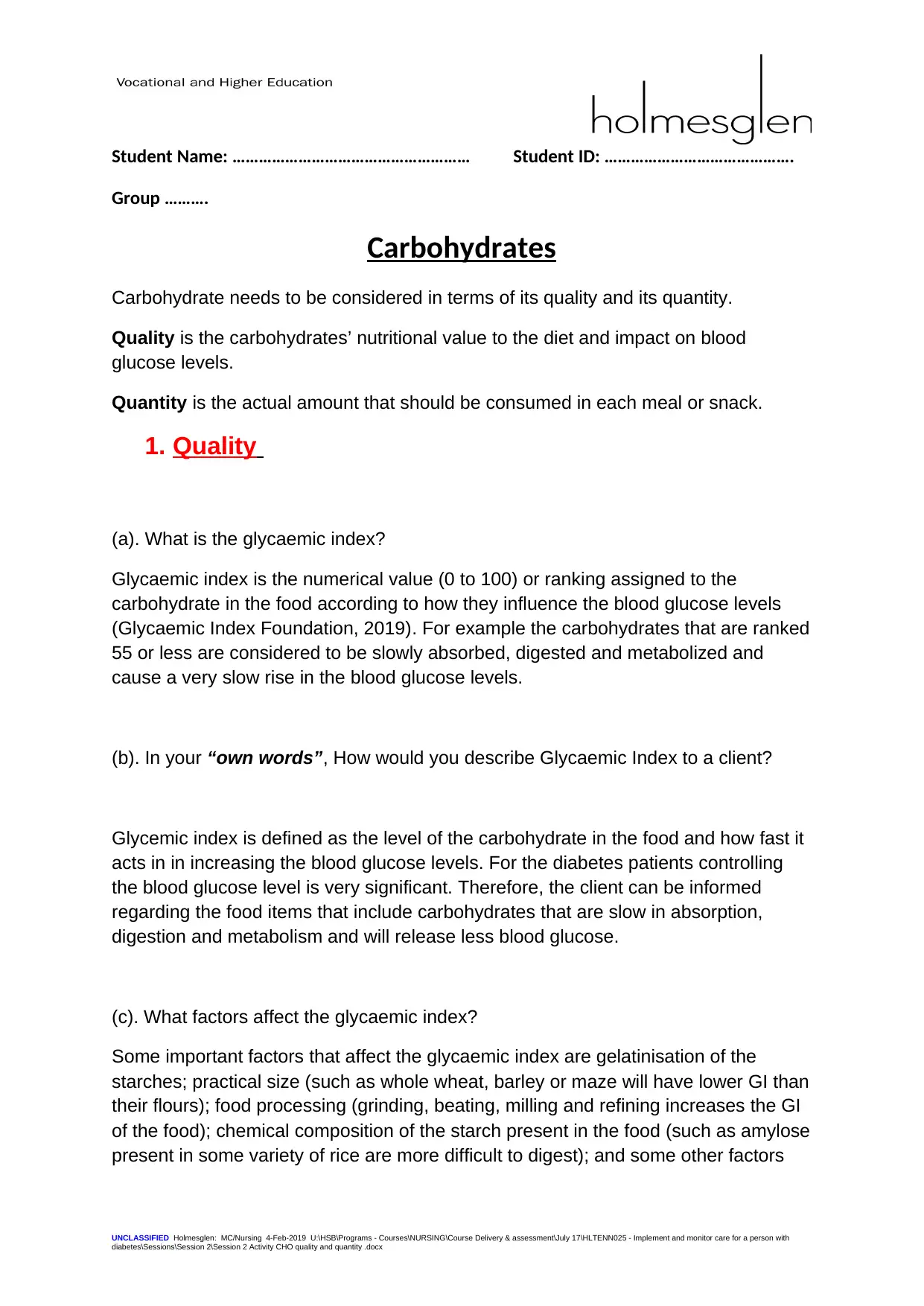
Student Name: ……………………………………………… Student ID: …………………………………….
Group ……….
Carbohydrates
Carbohydrate needs to be considered in terms of its quality and its quantity.
Quality is the carbohydrates’ nutritional value to the diet and impact on blood
glucose levels.
Quantity is the actual amount that should be consumed in each meal or snack.
1. Quality
(a). What is the glycaemic index?
Glycaemic index is the numerical value (0 to 100) or ranking assigned to the
carbohydrate in the food according to how they influence the blood glucose levels
(Glycaemic Index Foundation, 2019). For example the carbohydrates that are ranked
55 or less are considered to be slowly absorbed, digested and metabolized and
cause a very slow rise in the blood glucose levels.
(b). In your “own words”, How would you describe Glycaemic Index to a client?
Glycemic index is defined as the level of the carbohydrate in the food and how fast it
acts in in increasing the blood glucose levels. For the diabetes patients controlling
the blood glucose level is very significant. Therefore, the client can be informed
regarding the food items that include carbohydrates that are slow in absorption,
digestion and metabolism and will release less blood glucose.
(c). What factors affect the glycaemic index?
Some important factors that affect the glycaemic index are gelatinisation of the
starches; practical size (such as whole wheat, barley or maze will have lower GI than
their flours); food processing (grinding, beating, milling and refining increases the GI
of the food); chemical composition of the starch present in the food (such as amylose
present in some variety of rice are more difficult to digest); and some other factors
UNCLASSIFIED Holmesglen: MC/Nursing 4-Feb-2019 U:\HSB\Programs - Courses\NURSING\Course Delivery & assessment\July 17\HLTENN025 - Implement and monitor care for a person with
diabetes\Sessions\Session 2\Session 2 Activity CHO quality and quantity .docx
Group ……….
Carbohydrates
Carbohydrate needs to be considered in terms of its quality and its quantity.
Quality is the carbohydrates’ nutritional value to the diet and impact on blood
glucose levels.
Quantity is the actual amount that should be consumed in each meal or snack.
1. Quality
(a). What is the glycaemic index?
Glycaemic index is the numerical value (0 to 100) or ranking assigned to the
carbohydrate in the food according to how they influence the blood glucose levels
(Glycaemic Index Foundation, 2019). For example the carbohydrates that are ranked
55 or less are considered to be slowly absorbed, digested and metabolized and
cause a very slow rise in the blood glucose levels.
(b). In your “own words”, How would you describe Glycaemic Index to a client?
Glycemic index is defined as the level of the carbohydrate in the food and how fast it
acts in in increasing the blood glucose levels. For the diabetes patients controlling
the blood glucose level is very significant. Therefore, the client can be informed
regarding the food items that include carbohydrates that are slow in absorption,
digestion and metabolism and will release less blood glucose.
(c). What factors affect the glycaemic index?
Some important factors that affect the glycaemic index are gelatinisation of the
starches; practical size (such as whole wheat, barley or maze will have lower GI than
their flours); food processing (grinding, beating, milling and refining increases the GI
of the food); chemical composition of the starch present in the food (such as amylose
present in some variety of rice are more difficult to digest); and some other factors
UNCLASSIFIED Holmesglen: MC/Nursing 4-Feb-2019 U:\HSB\Programs - Courses\NURSING\Course Delivery & assessment\July 17\HLTENN025 - Implement and monitor care for a person with
diabetes\Sessions\Session 2\Session 2 Activity CHO quality and quantity .docx
Paraphrase This Document
Need a fresh take? Get an instant paraphrase of this document with our AI Paraphraser
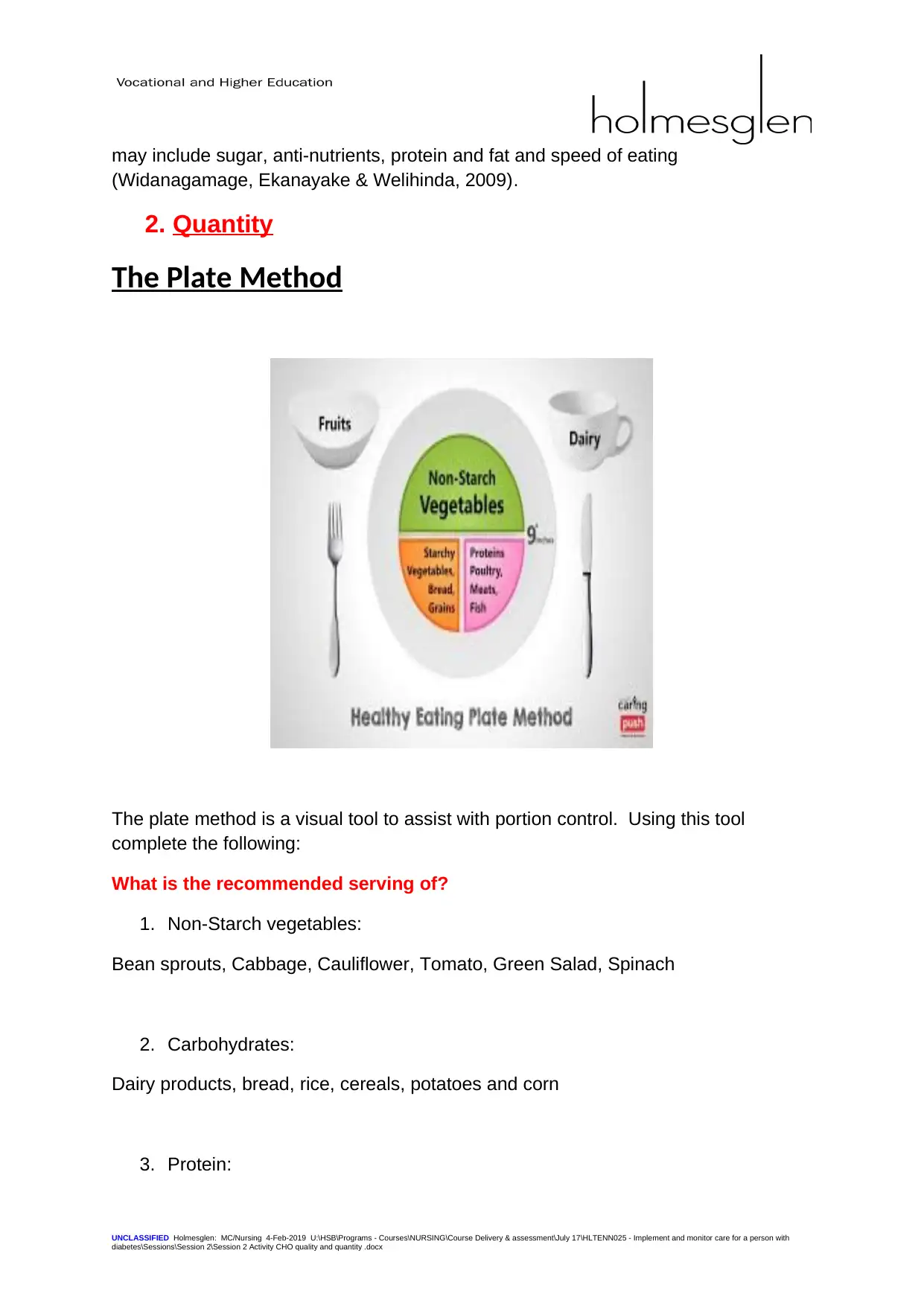
may include sugar, anti-nutrients, protein and fat and speed of eating
(Widanagamage, Ekanayake & Welihinda, 2009).
2. Quantity
The Plate Method
The plate method is a visual tool to assist with portion control. Using this tool
complete the following:
What is the recommended serving of?
1. Non-Starch vegetables:
Bean sprouts, Cabbage, Cauliflower, Tomato, Green Salad, Spinach
2. Carbohydrates:
Dairy products, bread, rice, cereals, potatoes and corn
3. Protein:
UNCLASSIFIED Holmesglen: MC/Nursing 4-Feb-2019 U:\HSB\Programs - Courses\NURSING\Course Delivery & assessment\July 17\HLTENN025 - Implement and monitor care for a person with
diabetes\Sessions\Session 2\Session 2 Activity CHO quality and quantity .docx
(Widanagamage, Ekanayake & Welihinda, 2009).
2. Quantity
The Plate Method
The plate method is a visual tool to assist with portion control. Using this tool
complete the following:
What is the recommended serving of?
1. Non-Starch vegetables:
Bean sprouts, Cabbage, Cauliflower, Tomato, Green Salad, Spinach
2. Carbohydrates:
Dairy products, bread, rice, cereals, potatoes and corn
3. Protein:
UNCLASSIFIED Holmesglen: MC/Nursing 4-Feb-2019 U:\HSB\Programs - Courses\NURSING\Course Delivery & assessment\July 17\HLTENN025 - Implement and monitor care for a person with
diabetes\Sessions\Session 2\Session 2 Activity CHO quality and quantity .docx
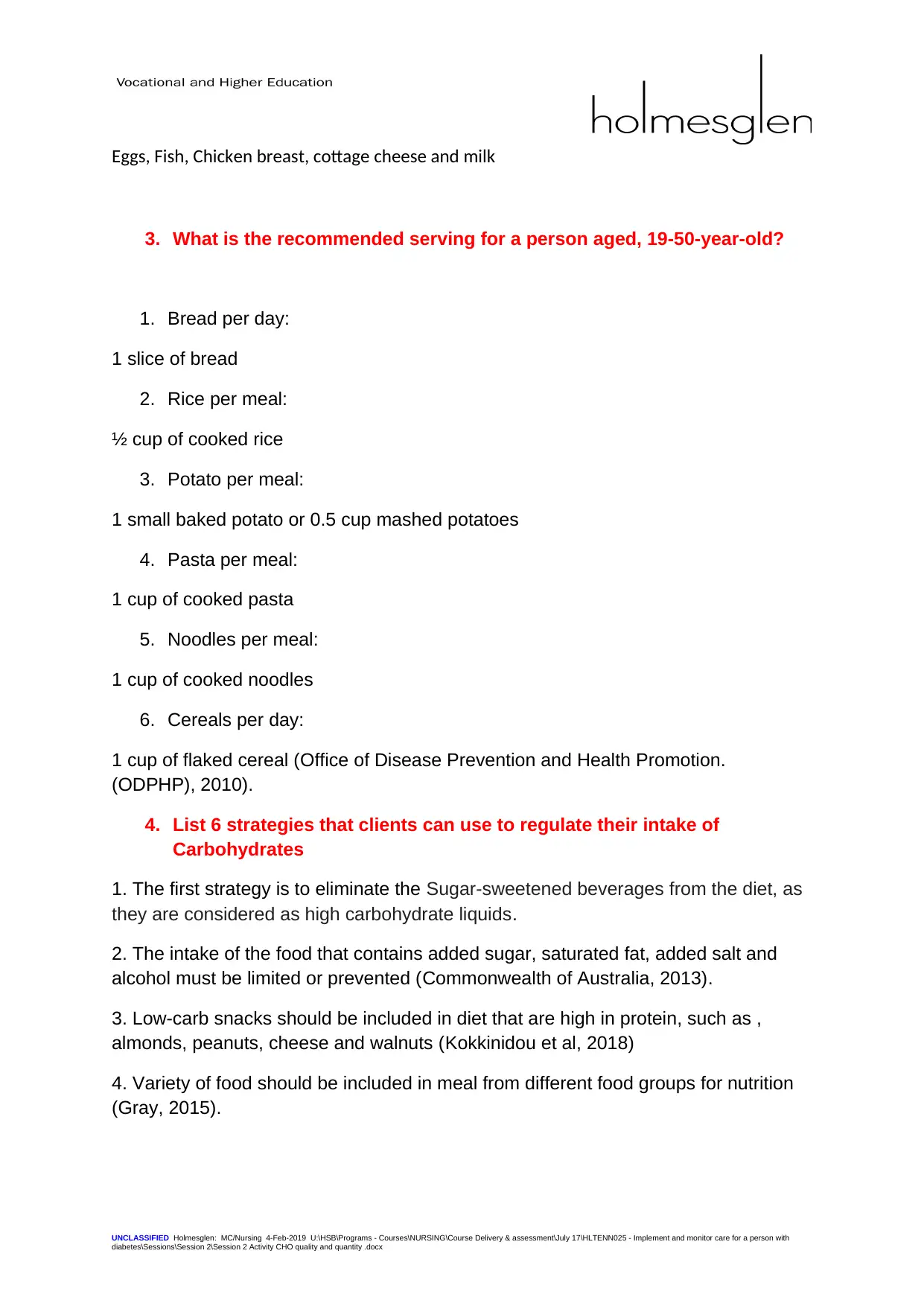
Eggs, Fish, Chicken breast, cottage cheese and milk
3. What is the recommended serving for a person aged, 19-50-year-old?
1. Bread per day:
1 slice of bread
2. Rice per meal:
½ cup of cooked rice
3. Potato per meal:
1 small baked potato or 0.5 cup mashed potatoes
4. Pasta per meal:
1 cup of cooked pasta
5. Noodles per meal:
1 cup of cooked noodles
6. Cereals per day:
1 cup of flaked cereal (Office of Disease Prevention and Health Promotion.
(ODPHP), 2010).
4. List 6 strategies that clients can use to regulate their intake of
Carbohydrates
1. The first strategy is to eliminate the Sugar-sweetened beverages from the diet, as
they are considered as high carbohydrate liquids.
2. The intake of the food that contains added sugar, saturated fat, added salt and
alcohol must be limited or prevented (Commonwealth of Australia, 2013).
3. Low-carb snacks should be included in diet that are high in protein, such as ,
almonds, peanuts, cheese and walnuts (Kokkinidou et al, 2018)
4. Variety of food should be included in meal from different food groups for nutrition
(Gray, 2015).
UNCLASSIFIED Holmesglen: MC/Nursing 4-Feb-2019 U:\HSB\Programs - Courses\NURSING\Course Delivery & assessment\July 17\HLTENN025 - Implement and monitor care for a person with
diabetes\Sessions\Session 2\Session 2 Activity CHO quality and quantity .docx
3. What is the recommended serving for a person aged, 19-50-year-old?
1. Bread per day:
1 slice of bread
2. Rice per meal:
½ cup of cooked rice
3. Potato per meal:
1 small baked potato or 0.5 cup mashed potatoes
4. Pasta per meal:
1 cup of cooked pasta
5. Noodles per meal:
1 cup of cooked noodles
6. Cereals per day:
1 cup of flaked cereal (Office of Disease Prevention and Health Promotion.
(ODPHP), 2010).
4. List 6 strategies that clients can use to regulate their intake of
Carbohydrates
1. The first strategy is to eliminate the Sugar-sweetened beverages from the diet, as
they are considered as high carbohydrate liquids.
2. The intake of the food that contains added sugar, saturated fat, added salt and
alcohol must be limited or prevented (Commonwealth of Australia, 2013).
3. Low-carb snacks should be included in diet that are high in protein, such as ,
almonds, peanuts, cheese and walnuts (Kokkinidou et al, 2018)
4. Variety of food should be included in meal from different food groups for nutrition
(Gray, 2015).
UNCLASSIFIED Holmesglen: MC/Nursing 4-Feb-2019 U:\HSB\Programs - Courses\NURSING\Course Delivery & assessment\July 17\HLTENN025 - Implement and monitor care for a person with
diabetes\Sessions\Session 2\Session 2 Activity CHO quality and quantity .docx
⊘ This is a preview!⊘
Do you want full access?
Subscribe today to unlock all pages.

Trusted by 1+ million students worldwide
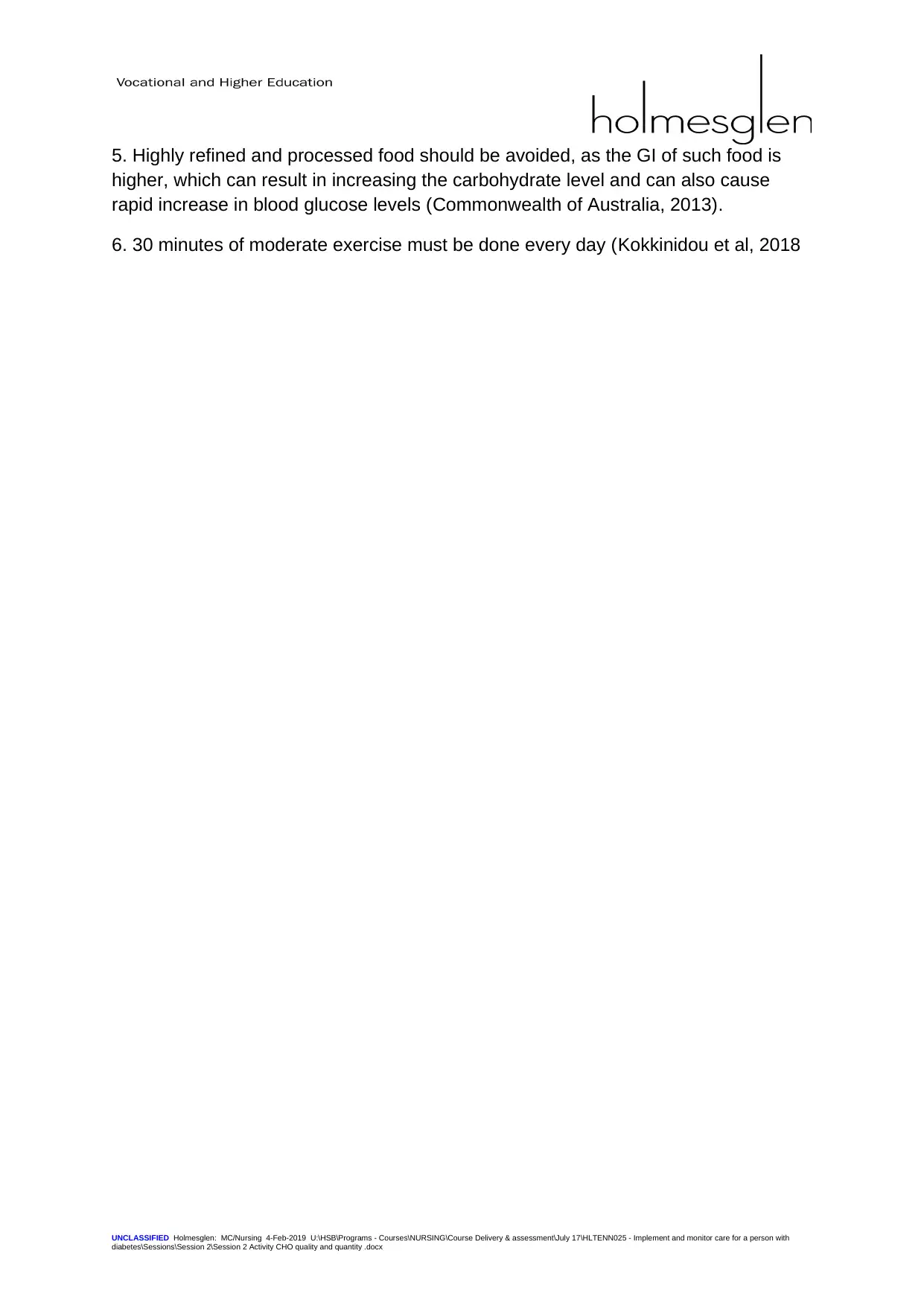
5. Highly refined and processed food should be avoided, as the GI of such food is
higher, which can result in increasing the carbohydrate level and can also cause
rapid increase in blood glucose levels (Commonwealth of Australia, 2013).
6. 30 minutes of moderate exercise must be done every day (Kokkinidou et al, 2018
UNCLASSIFIED Holmesglen: MC/Nursing 4-Feb-2019 U:\HSB\Programs - Courses\NURSING\Course Delivery & assessment\July 17\HLTENN025 - Implement and monitor care for a person with
diabetes\Sessions\Session 2\Session 2 Activity CHO quality and quantity .docx
higher, which can result in increasing the carbohydrate level and can also cause
rapid increase in blood glucose levels (Commonwealth of Australia, 2013).
6. 30 minutes of moderate exercise must be done every day (Kokkinidou et al, 2018
UNCLASSIFIED Holmesglen: MC/Nursing 4-Feb-2019 U:\HSB\Programs - Courses\NURSING\Course Delivery & assessment\July 17\HLTENN025 - Implement and monitor care for a person with
diabetes\Sessions\Session 2\Session 2 Activity CHO quality and quantity .docx
Paraphrase This Document
Need a fresh take? Get an instant paraphrase of this document with our AI Paraphraser
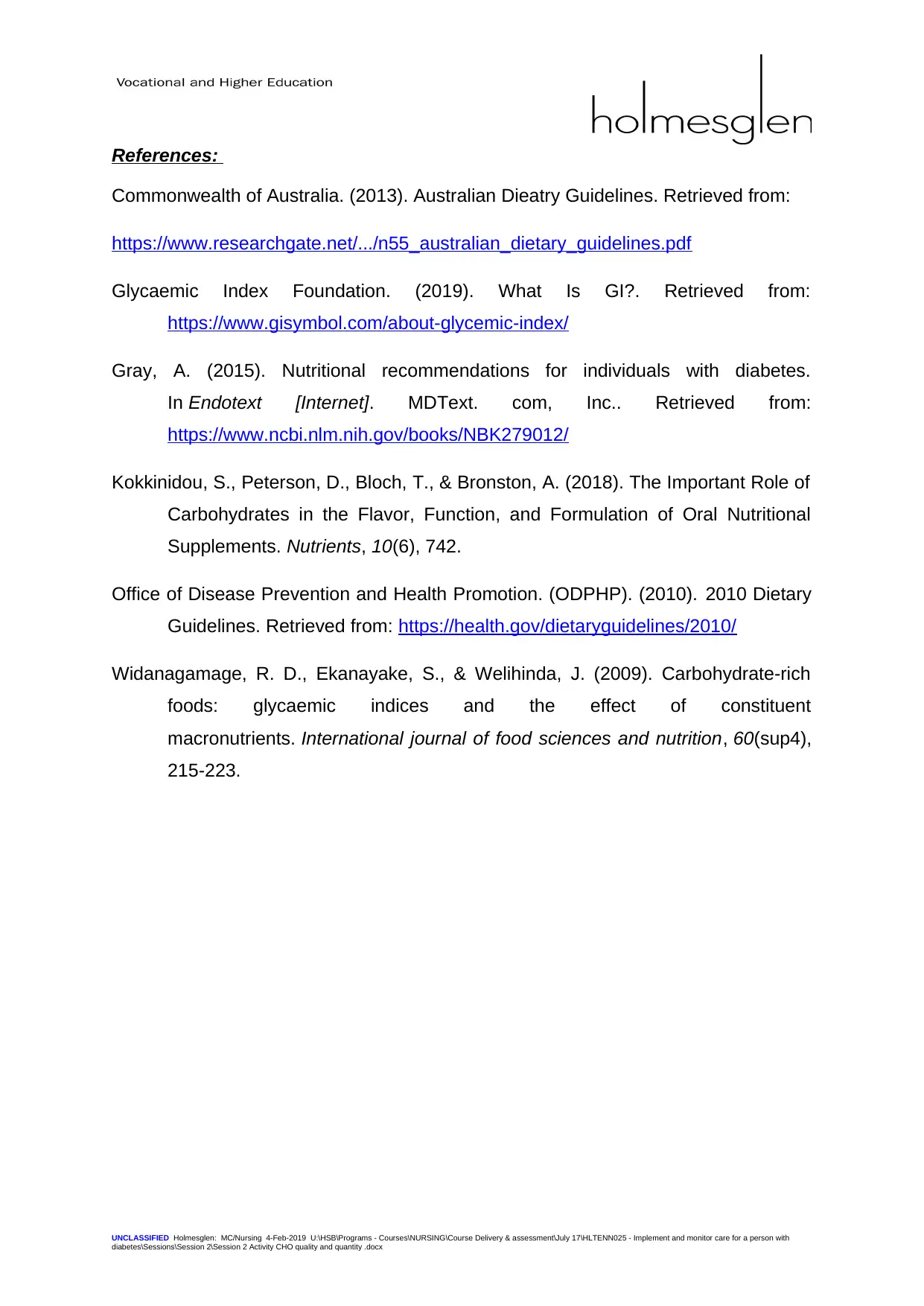
References:
Commonwealth of Australia. (2013). Australian Dieatry Guidelines. Retrieved from:
https://www.researchgate.net/.../n55_australian_dietary_guidelines.pdf
Glycaemic Index Foundation. (2019). What Is GI?. Retrieved from:
https://www.gisymbol.com/about-glycemic-index/
Gray, A. (2015). Nutritional recommendations for individuals with diabetes.
In Endotext [Internet]. MDText. com, Inc.. Retrieved from:
https://www.ncbi.nlm.nih.gov/books/NBK279012/
Kokkinidou, S., Peterson, D., Bloch, T., & Bronston, A. (2018). The Important Role of
Carbohydrates in the Flavor, Function, and Formulation of Oral Nutritional
Supplements. Nutrients, 10(6), 742.
Office of Disease Prevention and Health Promotion. (ODPHP). (2010). 2010 Dietary
Guidelines. Retrieved from: https://health.gov/dietaryguidelines/2010/
Widanagamage, R. D., Ekanayake, S., & Welihinda, J. (2009). Carbohydrate-rich
foods: glycaemic indices and the effect of constituent
macronutrients. International journal of food sciences and nutrition, 60(sup4),
215-223.
UNCLASSIFIED Holmesglen: MC/Nursing 4-Feb-2019 U:\HSB\Programs - Courses\NURSING\Course Delivery & assessment\July 17\HLTENN025 - Implement and monitor care for a person with
diabetes\Sessions\Session 2\Session 2 Activity CHO quality and quantity .docx
Commonwealth of Australia. (2013). Australian Dieatry Guidelines. Retrieved from:
https://www.researchgate.net/.../n55_australian_dietary_guidelines.pdf
Glycaemic Index Foundation. (2019). What Is GI?. Retrieved from:
https://www.gisymbol.com/about-glycemic-index/
Gray, A. (2015). Nutritional recommendations for individuals with diabetes.
In Endotext [Internet]. MDText. com, Inc.. Retrieved from:
https://www.ncbi.nlm.nih.gov/books/NBK279012/
Kokkinidou, S., Peterson, D., Bloch, T., & Bronston, A. (2018). The Important Role of
Carbohydrates in the Flavor, Function, and Formulation of Oral Nutritional
Supplements. Nutrients, 10(6), 742.
Office of Disease Prevention and Health Promotion. (ODPHP). (2010). 2010 Dietary
Guidelines. Retrieved from: https://health.gov/dietaryguidelines/2010/
Widanagamage, R. D., Ekanayake, S., & Welihinda, J. (2009). Carbohydrate-rich
foods: glycaemic indices and the effect of constituent
macronutrients. International journal of food sciences and nutrition, 60(sup4),
215-223.
UNCLASSIFIED Holmesglen: MC/Nursing 4-Feb-2019 U:\HSB\Programs - Courses\NURSING\Course Delivery & assessment\July 17\HLTENN025 - Implement and monitor care for a person with
diabetes\Sessions\Session 2\Session 2 Activity CHO quality and quantity .docx
1 out of 5
Related Documents
Your All-in-One AI-Powered Toolkit for Academic Success.
+13062052269
info@desklib.com
Available 24*7 on WhatsApp / Email
![[object Object]](/_next/static/media/star-bottom.7253800d.svg)
Unlock your academic potential
Copyright © 2020–2025 A2Z Services. All Rights Reserved. Developed and managed by ZUCOL.





